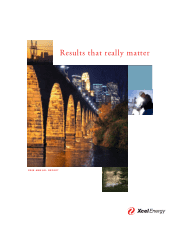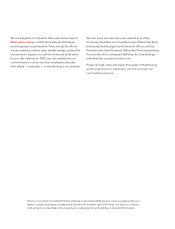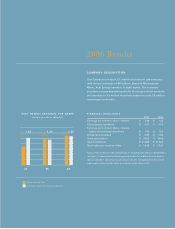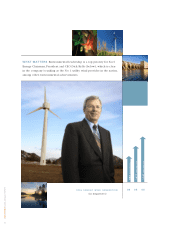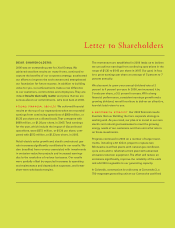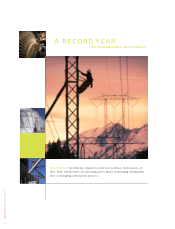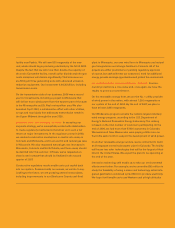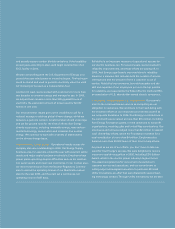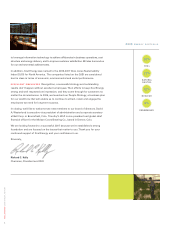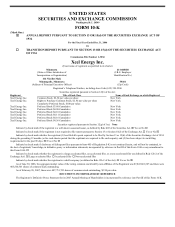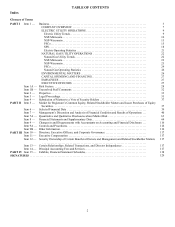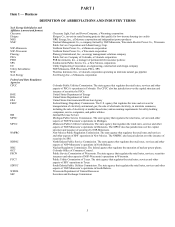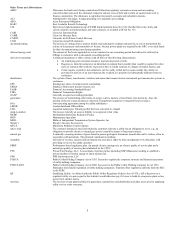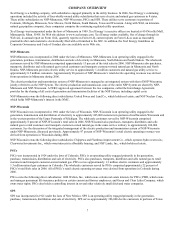Xcel Energy 2006 Annual Report Download - page 7
Download and view the complete annual report
Please find page 7 of the 2006 Xcel Energy annual report below. You can navigate through the pages in the report by either clicking on the pages listed below, or by using the keyword search tool below to find specific information within the annual report.
facility near Pueblo. We will own 500 megawatts of the new
unit, which should begin producing electricity by the fall of 2009.
Despite the fact that we will more than double the capacity of
the entire Comanche facility, overall sulfur dioxide and nitrogen
oxide emissions will decline significantly. That’s because we
are fitting all three generating units with advanced emission-
reduction equipment. Our investment is $1.35 billion, including
transmission costs.
On the transmission side of our business, 2006 was a record
year for investments, including a project in Minnesota that
will deliver more wind power from the western part of the state
to the Minneapolis and St. Paul metropolitan area. We also
launched CapX 2020, a collaborative effort with other utilities,
co-ops and municipals that addresses transmission needs in
the Upper Midwest through the year 2020.
E A R N I N G O U R A U T H O R I Z E D R E T U R N In executing our
corporate strategy, we’ve successfully worked with stakeholders
to create regulatory mechanisms that allow us to earn a fair
return on major investments. In the regulatory arena in 2006,
we reached constructive conclusions in electric rate cases in
Colorado and Minnesota, and in an electric and natural gas case
in Wisconsin. We also requested natural gas rate increases in
Minnesota, Colorado and North Dakota, and those cases should
be decided later this summer. In Texas, we’ve requested an
electric rate increase that should be finalized in the second
quarter of 2007.
Constructive regulatory results enable us to put capital back
into our system. Success builds on success, as we like to say.
Looking to the future, we are pursuing several new projects,
including improvements to our Sherburne County coal-fired
plant in Minnesota, our own wind farm in Minnesota and natural
gas transportation and storage facilities in Colorado. All of the
projects are either preliminary or pending regulatory approval,
of course, but each will meet our customers’ need for additional
energy, provide earnings opportunities and protect the environment.
A N O U T S TA N D I N G E N V I R O N M E N T A L R E C O R D Environ-
mental protection is a core value and, once again, we have the
results to prove our commitment.
On the renewable energy front, we are the No. 1 utility provider
of wind power in the nation, with almost 1,300 megawatts on
our system at the end of 2006. By the end of 2007, we plan to
have at least 2,800 megawatts.
Our Windsource program remains the nation’s largest voluntary
wind energy program, according to the U.S. Department of
Energy’s National Renewable Energy Laboratory. The ranking
is based on the total number of customers participating. At the
end of 2006, we had more than 57,000 customers in Colorado,
Minnesota and New Mexico who were paying a little more on
their bills each month to support the development of wind power.
In another renewable energy venture, we’ve contracted to build
an 8-megawatt central solar power plant in Colorado. The facility
will house two solar technologies that will be the largest of their
kind in the United States. We expect the plant to be operating at
the end of the year.
Innovative technology will enable us to take our environmental
efforts even further. For example, we’ve committed $6 million to
study the feasibility of using a clean coal technology called inte-
grated gasification combined cycle (IGCC) to produce electricity.
We hope it will enable us to use Western coal at high altitudes

